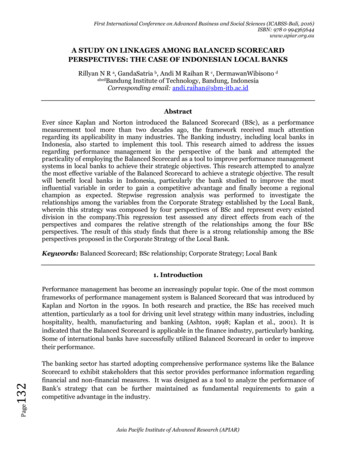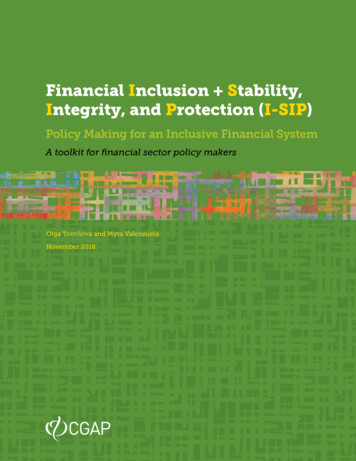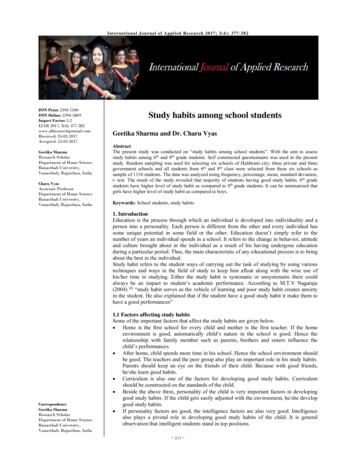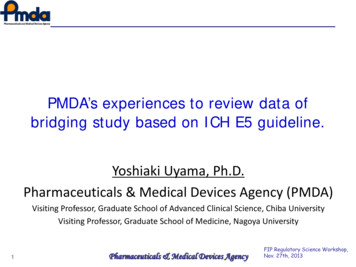
Transcription
First International Conference on Advanced Business and Social Sciences (ICABSS-Bali, 2016)ISBN: 978 0 994365644www.apiar.org.auA STUDY ON LINKAGES AMONG BALANCED SCORECARDPERSPECTIVES: THE CASE OF INDONESIAN LOCAL BANKSRillyan N R a, GandaSatria b, Andi M Raihan R c, DermawanWibisono dabcdBandung Institute of Technology, Bandung, IndonesiaCorresponding email: andi.raihan@sbm-itb.ac.idAbstractEver since Kaplan and Norton introduced the Balanced Scorecard (BSc), as a performancemeasurement tool more than two decades ago, the framework received much attentionregarding its applicability in many industries. The Banking industry, including local banks inIndonesia, also started to implement this tool. This research aimed to address the issuesregarding performance management in the perspective of the bank and attempted thepracticality of employing the Balanced Scorecard as a tool to improve performance managementsystems in local banks to achieve their strategic objectives. This research attempted to analyzethe most effective variable of the Balanced Scorecard to achieve a strategic objective. The resultwill benefit local banks in Indonesia, particularly the bank studied to improve the mostinfluential variable in order to gain a competitive advantage and finally become a regionalchampion as expected. Stepwise regression analysis was performed to investigate therelationships among the variables from the Corporate Strategy established by the Local Bank,wherein this strategy was composed by four perspectives of BSc and represent every existeddivision in the company.This regression test assessed any direct effects from each of theperspectives and compares the relative strength of the relationships among the four BScperspectives. The result of this study finds that there is a strong relationship among the BScperspectives proposed in the Corporate Strategy of the Local Bank.Keywords: Balanced Scorecard; BSc relationship; Corporate Strategy; Local Bank1. IntroductionThe banking sector has started adopting comprehensive performance systems like the BalanceScorecard to exhibit stakeholders that this sector provides performance information regardingfinancial and non-financial measures. It was designed as a tool to analyze the performance ofBank’s strategy that can be further maintained as fundamental requirements to gain acompetitive advantage in the industry.Page132Performance management has become an increasingly popular topic. One of the most commonframeworks of performance management system is Balanced Scorecard that was introduced byKaplan and Norton in the 1990s. In both research and practice, the BSc has received muchattention, particularly as a tool for driving unit level strategy within many industries, includinghospitality, health, manufacturing and banking (Ashton, 1998; Kaplan et al., 2001). It isindicated that the Balanced Scorecard is applicable in the finance industry, particularly banking.Some of international banks have successfully utilized Balanced Scorecard in order to improvetheir performance.Asia Pacific Institute of Advanced Research (APIAR)
First International Conference on Advanced Business and Social Sciences (ICABSS-Bali, 2016)ISBN: 978 0 994365644www.apiar.org.auThis research is aimed at addressing the issues regarding performance management with theperspective of the bank and attempted the practicality of employing Balanced Scorecard as a toolto improve performance management systems in local banks to achieve their strategicobjectives.2. The Problems of Performance Management in Local BanksWith the rapid growth of the banking industry, local bank are dealing with intense competition.Based on the Association of Local Bank (ASBANDA) in Indonesia, local bank find difficulties tocompete against commercial bank in each region. Further, ASBANDA established a jointprogram called Local Bank Regional Champion (BRC) to encourage local banks in Indonesia tobe more competitive and become a regional champion comparable with commercial banks.In order to obtain this BRC objective, ASBANDA has indicated four comparative weaknesses ofthe local bank that needs to be improved, such as: (1) Human Capital, (2) Credit Loan, (3)Recording Governance System, and (4) Performance Management System. Related to the fourthaspect, Performance Management System, BRC suggested that local banks start to implementthe Balanced Scorecard as tool to improve current performance systems to achieve theirstrategic objective.This research is aimed to analyze the most effective variable of the Balanced Scorecard toachieve strategic objective. The result will help benefit local banks in Indonesia, particularly thebank studied to improve the most influential variable in order to gain a competitive advantageand finally become a regional champion as expected.3. Implementation of the Balance Scorecard andPerformance Management Systems At Local BanksA. The Basic Theory of Balance ScorecardPage133Balance scorecard is a strategic management system that helps organizations to identifystrategies and make it executable (Braam&Nijssen, 2004; Chen, Chen&Peng, 2008). BSC wasdevised and designed by Robert Kaplan of Harvard University and David Norton, who wasworking as a consultant in the Boston area in 1992 (Kaplan&Norton, 1992). Kaplan and Nortonthought that measuring financial performance is not enough and affected the companies’ abilityto create value These companies must also concern itself with issues relating to the customer,internal processes and commercial matters relating to staff and stakeholders can effectivelycontribute to the assessment of organizational performance. Kaplan and Norton called this toolthe “Balance Scorecard”(Kaplan&Norton, 1996; Feizi&Solukdar, 2014). Balance scorecard hasseveral particular functions such as (Sharma, 2009): Translate vision and strategy; Defines the strategic linkage to integrate performance across organizations; Communicates objectives and measures to a business unit, joint venture, or sharedservice;Asia Pacific Institute of Advanced Research (APIAR)
First International Conference on Advanced Business and Social Sciences (ICABSS-Bali, 2016)ISBN: 978 0 994365644www.apiar.org.au Aligns strategic initiatives; Align everyone within an organization so that all employees understand how and whatthey do supports the strategy; Provide a basis for compensation; and Provides feedback to the senior management if the strategy is workingBalanced Scorecard has four perspectives; Financial perspective Customer perspective Internal business perspective Learning and growth perspectiveFour perspectives from the balance scorecard were assessed to see if these companies are fit andproper to generate profit. This is because all perspectives from balance scorecard representingrelationship analysis both from internal and external factors directly to business. In terms ofbuilding the strategy, balance scorecard transforms the strategy objectives of the company intothe strategic level with assessment of performance organization (Yansheng&Longyi, 2009).B. BSC Performance Management System Model Related with Bank IndustrySimilar to other industries, banks can not only focus on financial perspective, they need toevaluate their performance activities and to assess the achievement of strategic objectives(Secme, Bayrakdaroglu&Kahraman, 2009). When competitiveness is increasing, banks need tobe able to find their competitive advantage to evaluate the performance of the organization andfind the appropriate ways (Wu, Tseng&Chen, 2009). Bank has special ways to analyze andevaluate their performance activities with specific calculation or framework. Otherwise, theframework design is able to set it as a tool to analyze the performance of the Bank’s strategy isone of the fundamental requirement (Jiang&Liu, 2013). The implementation of BalancedScorecard in Bank as follow:Customers. Banking industry has high sensitivity in customer satisfaction, and it is also appliedin the local bank. Despite of local bank already having a major customer such local government,which reflects no significant threats of decreasing customers. It is not like local banks to putaside the main objective ofimproving their customer satisfaction. However, local bank needs toconcern on other factors in customer perspective such as customer retention rate, customerprofitability level and market share (Yansheng&Longyi, 2009).Page134Financial perspective. In the Balanced Scorecard framework, financial perspective acted as aparameter of the organization result. Bank in particular, have many financial indicatorsmeasured to define which indicators are parts of the chain that caused and affected existingstrategic objectives (Rostami, Goudarzi&Zaj, 2015).Asia Pacific Institute of Advanced Research (APIAR)
First International Conference on Advanced Business and Social Sciences (ICABSS-Bali, 2016)ISBN: 978 0 994365644www.apiar.org.auInternal business process. In the internal business process, it is related to operation excellenceand improvement. The main purpose from internal business process improvement is to meetthe requirement of shareholders, especially in financial returns, and for stakeholders in terms ofcustomer need and requirements (Perlman, 2013). Learning and growth. Similar with commercial bank, local bank needs to consider theirlearning and growth as an investment for the long-term performance. The concern is notonly for ability improvement, but focus is on implementation of information systemintegration, and being vision of the company (Perlman, 2013).C. Performance Indicator at Local BankThere are five principles of successful organizations emerged from Kaplan and Norton’sresearch on successful balanced scorecard users. These key elements of building an organizationable to focus on strategy and deliver breakthrough result (Sharma, 2009), they are; Mobilize change through executive leadership; Translate the strategy into operational terms; Align the organization to the strategy; Make strategy everyone’s job and Make strategy a continual process.Page135These principals lead to the establishment of performance indicators that have beenimplemented in various industries, including banking industry. Most of the bank (commercialbank, local bank, etc) determine the variable and indicators which are suitable to their strategyas seen in the picture below:Asia Pacific Institute of Advanced Research (APIAR)
First International Conference on Advanced Business and Social Sciences (ICABSS-Bali, 2016)ISBN: 978 0 994365644www.apiar.org.auFigure 1.1. Common Indicator Performance at Bank Source: Authors (2015)D. BSC Implementation at Local BankThe local bank determines their strategy projection that disembogues from the consolidationstrategy of product innovation, operation excellence, market penetration and marketdevelopment. In term of product innovation, local bank purposes to improve markets througheither innovation development of existing product and services, creating the new product andservices, or both.The strategy projection was composed from many direct factors to local bank such as scope,time, measurement, objectives and the operation processes. The Figure below illustrates thelinkage using a subsample from the Corporate Strategy established by the Local Bank team,wherein composed by four perspectives of BSc and represent every existed division in thecompanyPage136Regarding the operation excellence in local bank, their mission is to keep the profitability rate byconducting the efficiency in whole area. While market penetration is associated with leverage,the market with extra marketing efforts in the existing market is successful. For the last aspect,market development in local bank is related to aiming for potential market.Asia Pacific Institute of Advanced Research (APIAR)
First International Conference on Advanced Business and Social Sciences (ICABSS-Bali, 2016)ISBN: 978 0 994365644www.apiar.org.auFigure 1.2 Local Bank Corporate StrategySource: Authors (2015)4. Research MethodologyPage137In this research, authors tried to calculate the relationship between variables that come fromdifferent perspective from Corporate Strategy established by the Local Bank team, to indicatewhich strategic objective that most optimal to achieve profitability of local bank. Based on theabove discussion, authors formulated the following hypotheses as illustrated in figure below:Asia Pacific Institute of Advanced Research (APIAR)
First International Conference on Advanced Business and Social Sciences (ICABSS-Bali, 2016)ISBN: 978 0 994365644www.apiar.org.auFigure 1.3 Hypothesis Based on Local Bank Corporate StrategySource: Authors (2015)According to the above figure, this research is aimed at formulating 19 hypotheses that therelationship would be assessed and tried to indicate the strongest influential strategic objective.The Independent variable in this Local Bank Corporate Strategy is Learning and Growth,Internal Business, and Customer Perspective. Special case for Internal Business and CustomerPerspectives, these variables functioned both as an independent variable and dependentvariable (affecting and affected). Meanwhile, financial perspectives on this research aredependent variables (as a goal of strategy), which means it is affected by other perspectives.Page138Furthermore, after ascertain every existed variables, Expert Judgment Method wasimplemented in order to figure out measuring instrument that is most applicable for everystrategic objectives. Expert Judgment collected from Chief Executive Office (CEO) of the LocalBank combined with head division of related Corporate Strategy.Authors performed stepwise regression analysis in order to comprehend more about therelationship between several independent or predictor variables and a dependent or criterionvariable and to investigate the relationships among the variables described in Figure above. InStepwise regression analysis, variables stated to have relationships when the result of the valueis above 0.5 ( 0.5). This regression test assessed any direct effects from each of the perspective,and compares the relative strength of the relationships among the four BSc perspectives.Asia Pacific Institute of Advanced Research (APIAR)
First International Conference on Advanced Business and Social Sciences (ICABSS-Bali, 2016)ISBN: 978 0 994365644www.apiar.org.au5. Result and DiscussionIn this research, the hypothesis of the Corporate Strategy at local bank consists of severalvariables that is linked around BSc perspective at the local bank. To achieve the final result ofthis research, the data from local bank calculated uses stepwise regression among perspectives.There are 19 linkage measured using this method, and resulted as follows:Table 1.1 Regression 3H14H15H16H17H18H19Independent F12F4F8C3C3C4C4C2C2C2P7P1P7P6P3P3P9P9Adjusted 00,769Source: SPSS 22 Result processed by AuthorsPage139Based on the above table, from 19 perspectives that have been calculated, there are two variablesthat have adjusted ratio less than ( ) 0.5. Those variables are P8 (Improve Loan EffectivityMonitoring) towards F8 (Increase Credit Quality) and P3 (Services Quality Improvement)towards C3 (Brand Image Development). This result means that these factors do not contributesignificant impact to Strategic Objective.Meanwhile, the other 17 hypotheses occurred linkage variables that have adjusted ratio morethan ( ) 0.5 which means independent variable proved influenced dependent variable. Refer toto these finding, local bank can compare the value of variables in the same perspective. Thevalue of each variable can be stated as follows:Asia Pacific Institute of Advanced Research (APIAR)
First International Conference on Advanced Business and Social Sciences (ICABSS-Bali, 2016)ISBN: 978 0 994365644www.apiar.org.auTable 1.2 Independent Variables Average ValuePerspectiveIndependentVariablesL2. Improving theEffectiveness ofPerformanceManagementLearning &GrowthL6. StrengthenLeadership and Cultureof the CompanyP1. Product/ ServicesDevelopmentP02. Development ofNew Electronic andPhysical 03. Services QualityImprovementP04. ImproveEffectiveness ofCorporate SocialResponsibilty ProgramP06. Conduct StartegicDependent VariableAdjustedRsquareValueP7. ImproveEffectiveness of RiskManagement,Obedience, andInternal ControlP1. Product/ ServicesDevelopmentP6. Conduct StartegicAllianceP03. Services QualityImprovementP09. Improve Qualityand Productivity ofBusiness ProcessP7. ImproveEffectiveness of RiskManagement,Obedience, andInternal ControlP03. Services QualityImprovementP09. Improve Qualityand Productivity ofBusiness ProcessC02. Optimalizationand Expanding MarketC02. Optimalizationand Expanding MarketC04. ImprovingSatisfaction and Fulfillthe Customers NeedsC03. Brand ImageDevelopmentC04. ImprovingSatisfaction and Fulfillthe Customers 800,815C03. Brand ImageDevelopment0,8290,829C02. Optimalization0,8430,843Asia Pacific Institute of Advanced Research (APIAR)
First International Conference on Advanced Business and Social Sciences (ICABSS-Bali, 2016)ISBN: 978 0 994365644www.apiar.org.auAllianceand Expanding MarketP08. Improve LoanEffectivity MonitoringF08. Increase CreditQualityF12. Operating CostOptimalizationF13. Investment CostOptimalizationF04. Increase FeeBased IncomeP09. Improve Qualityand Productivity ofBusiness ProcessCustomerC01. Increase urce: SPSS 22 Result processed by AuthorsFurthermore, from the table above, there are two linkage that have a high score. Therelationship between P9 (Improve Quality and Productivity of Business Process) towards F12(Operating Cost Optimalization) and relationship between P2 (Development of New Electronicand Physical Network Distribution) towards C2 (Optimalization and Expanding Market) hasstrong relationship. It means that improving these two factors could drive significant benefit forlocal banks in terms of developing their competitive advantage in the market.In accordance to table 1.2, local bank able to define which perspective have significant impact onCorporate Performance. In learning and growth perspective, Improving the Effectiveness ofPerformance Management influenced five variables in internal business process and have 0.761average value. While in other terms, Strengthen Leadership and Culture of The Companyinfluenced three variables in internal business process but has higher average value with 0.771.Because of considerations on management with respect to investment, local bank shall concernon Improving Effectiveness of Performance Management because it has lower value andinfluence five other variables.In terms of Internal Business Process, there are seven variables that have impact on customerperspectives, while the other three variables have impact on financial perspective. Moreover, theresult also indicated that the Development of New Electronic and Physical Network Distributionis the highest variable with average value 0,89 in business process perspective. It means thatthese aspect have strong impact in internal business process, rather than other aspects in thisperspectives.This research aimed to analyze the relationship of non-financial perspectives to financialperspectives in BSc framework in Corporate Strategy of Local Bank. This research indicated thatfrom 19 variables in hypotheses that been measured in this research, only 17 variablessignificantly influence local bank performances. Moreover, this research also providesinformation about the key variable of Local Bank that should be optimized in order to improveperformance of the company.Page141ConclusionAsia Pacific Institute of Advanced Research (APIAR)
First International Conference on Advanced Business and Social Sciences (ICABSS-Bali, 2016)ISBN: 978 0 994365644www.apiar.org.auFurthermore, this research generated evidence that Corporate Strategy could help company todetermine the linkage among BSc perspectives. The Expert Judgment Method contributed tothis research in terms of variable formulation.Page142However, this research has several limitations related to limited number of variable measuredand specifically implemented in bank industry. Further research for other industries isrecommended to enhance understanding about the application of BSc. Additional measures forthe variables and different methodology also could be use in further research.Asia Pacific Institute of Advanced Research (APIAR)
First International Conference on Advanced Business and Social Sciences (ICABSS-Bali, 2016)ISBN: 978 0 994365644www.apiar.org.auReferencesBraam, G. J. &Nijssen, E. J., 2004. Performance Effects of Using the Balance Scorecard: A Noteon the Dutch Experience. Long Range Planning, 37(4), pp. 335-349.ii.Chen, T. Y., Chen, C. B. & Peng, S. Y., 2008. Firm Operation Performance Analysis Using DataDevelopment Analysis and Balance Scorecard: A Case Study of a Credit Cooperative Bank.International Journal of Productivity and Performance Management, 57(7), pp. 523-539.iii.Feizi, A. &Solukdar, A., 2014. Combined with A Balance Scorecard Approach to PerformanceAssessment of the Banking Industry – with Fuzzy TOPSIS Method. Engineering andManagement of Securities, 20, pp. 57-78.iv.Jiang, L. & Liu, H., 2013. A Multi-Criteria Group Decision Making Model for PerformanceEvaluation of Commercial Banks. In Fuzzy Systems and Knowledge Discovery (FSKD), 2013 10 thInternational Conference, IEEE, pp. 940-945.v.Kaplan, R. S. &Norton, D. P., 1992. The Balance Scorecard - Measures That Drive Performance.Harvard Business Review, 70(1), pp.71-79.vi.Kaplan, R. S. & Norton, D. P., 1996. Translating Strategy into Action the Balance Scorecard.Boston: Harvard Business School Press.vii.Perlman, Y., 2013. Causal Relationship in the Balance Scorecard: A Path Analysis Approach.Journal of Management and Strategy, 4(1).viii.Rostami, M., Goudarzi, A. &Zaj, M., M., 2015. Defining Balance Scorecard Aspects in BankingIndustry Using FAHP Approach. AIS International Conference, 1(1), pp. 25-38.ix.Sharma, A., 2009. Implementing Balance Scorecard for Performance Measurement. The IUPJournal of Business Strategy, 6(1).x.Secme, N. Y., Bayrakdaroglu, A. &Kahraman, C., 2009. Fuzzy Performance Evaluation in TurkishBanking Sector Using Analytic Hierarchy Process and TOPSIS. Expert System with Application,36(9), pp. 11699-11709.xi.Wu, H. Y., Tseng, G. H. & Chen, Y. H., 2009. A Fuzzy MCDM Approach for Evaluating BankingPerformance Based On Balance Scorecard. Expert System with Applications, 36(6), pp. 1013510147.xii.Yansheng, Z. &Longyi, L., 2009. Study on Balanced Scorecard of Commercial Bank inPerformance Management System.Page143i.Asia Pacific Institute of Advanced Research (APIAR)
Asia Pacific Institute of Advanced Research (APIAR) e 132 A STUDY ON LINKAGES AMONG BALANCED SCORECARD PERSPECTIVES: THE CASE OF INDONESIAN LOCAL BANKS Rillyan N R a, GandaSatria b, Andi M Raihan R c, DermawanWibisono d abcdBandung Institute of Technology, Bandung, Indonesia Corresponding email: andi.raihan@sbm-itb.ac.id Abstract










